Description of the Daikon Minovashi variety, features of cultivation and care
Daikon Minovashi, which has several subspecies, differs from the radish familiar to Europeans in taste, shape and content of nutrients. Crops of root crops bred by the Japanese occupy vast areas in this state. Residents of the Land of the Rising Sun prepare side dishes from vegetables, eat young shoots with pleasure, canned and pickle both leaves and roots. Perhaps due to the rich composition of the daikon, the Japanese have an amazing ability to work, live a long time.
Description of the variety
A distant relative of mid-season vegetable species is the forehead. By crossing this green radish, the Japanese got a root crop, which they have the same distribution as potatoes in Europe and America. In Russia, some summer residents have been growing Minovasi for almost 10 years. It is this variety that is present in the register of breeding achievements.
A daikon root vegetable is much larger than a radish. In 2 months, it grows in length to almost half a meter. The diameter of the upper part of the vegetable does not exceed 10 cm, it tapers from below. The "big root" has:
- cylindrical;
- delicate and thin skin;
- juicy and dense pulp;
- sweetish taste.
The dissected leaves are folded into a beautiful rosette. They, like root crops, do not accumulate pesticides, toxic substances and are consumed fresh. Ripening a vegetable, it rises above the garden bed, hiding from above with lush greenery.
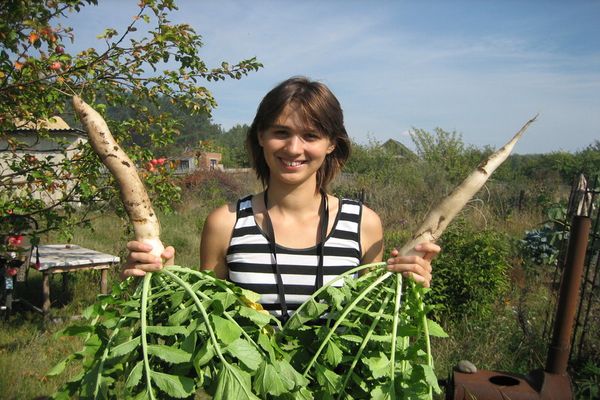
Minovashi's refreshing pulp contains:
- pectins;
- phytoncides;
- proteins;
- beta carotene;
- trace elements.
The root vegetable helps to cleanse the body of toxins and toxins. When it is used, edema passes, the liver restores its functions, radioactive particles are removed, and cholesterol levels decrease. The vegetable accelerates the treatment of influenza, copes with acute respiratory infections.

Growing
Minovashi belongs to the late daikon varieties, ripens after 70 days, but the root crop is good and green. The beneficial properties of a ripe vegetable are preserved until winter. To grow it, you need timely planting and care.
If you choose the right time for sowing, the root will develop quickly. In the heat and long daylight hours, the culture blooms, and the vegetable will be small, will not please with juiciness and taste.
If you plant Minovashi in March or April, it will not ripen until July, and this month the heat begins, the plant shoots arrows. In the south, it is better to start sowing in August. In the middle lane, you need to monitor the weather. In order for the root crop to ripen, it is advisable to plant this daikon variety in the second half of summer.
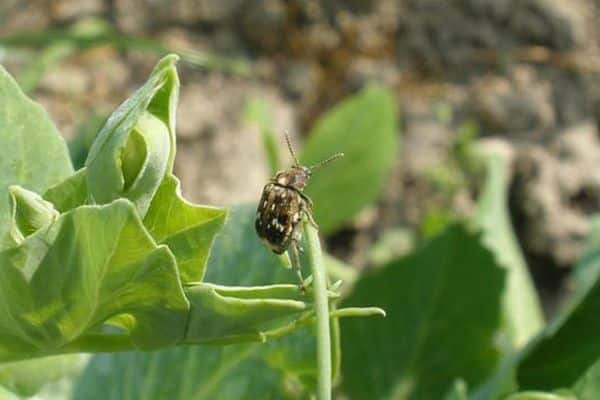
When sown after July 15, Minovashi is not affected by insects. Cruciferous fleas do not tolerate cold nights. Since the top of the vegetable rises above the ground, it is spud or covered with an agricultural canvas.Thanks to this, frosts that come to Russia after the 2nd decade of September will not harm the plant.
Experienced gardeners advise beginners to sow a vegetable in the middle of summer, and then a couple of weeks later. This will help you find the optimal planting time for Minovashi.
Preparation of beds and seeds
In order for the daikon to reward large root crops with a plot for him, you need to select where the rays of the sun fall all day. It is better to grow a vegetable where it was previously planted:

- tomatoes;
- potatoes;
- onion;
- cucumbers.
Cruciferous crops, radishes and cabbage are unsuccessful predecessors for daikon.
The Minovashi variety is undemanding to the soil, but it is rather difficult to pull the root crop out of the clay. To correct the situation, loosening the soil allows. For this, peat and straw, sawdust and dry leaves, cut grass and chopped bark are suitable.

Before digging, the soil in the garden is fertilized. A glass of ash and a bucket of humus are taken per square meter of area. For feeding, you can also use a spoonful of superphosphate, urea and calcium salt.
Minovashi seed holes are marked every 20 centimeters, up to 70 cm are left between the rows.Some gardeners prefer a 40x40 planting scheme. When laying seeds of 20 mm, roots sprout quickly and amicably. So that the soil in the garden is not covered with a crust, summer residents act differently:
- Furrows are made at a distance of 60 centimeters.
- Water is poured into them, grains are put.
- Pour earth on top.
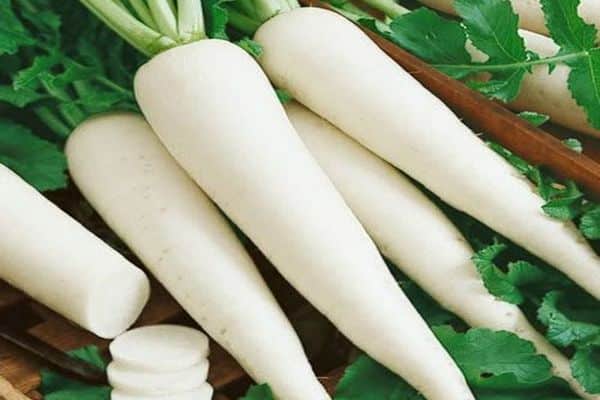
The Minovashi daikon is not grown by seedlings, since the culture does not tolerate picking. Large vegetables are harvested from fertile and light soils; on acidic soils, the yield is much lower.
Before planting Minovashi seeds on a garden bed, they are placed in water, the temperature of which is about 50 degrees, after 20 minutes they are transferred to ice. Then they are sent to the refrigerator for a day. After stratification, the seed is soaked in a potassium permanganate solution.
Root crops are stored for a long time if planting is done in July. Harvested in the fall before the start of frost.
Care features
When sprouts appear, Minovashi usually needs to be thinned out. The land under the crop must be loosened, watered, and weeds removed. Lack of moisture leads to the fact that bitterness appears in the root crops, with an excess of it, they crack.
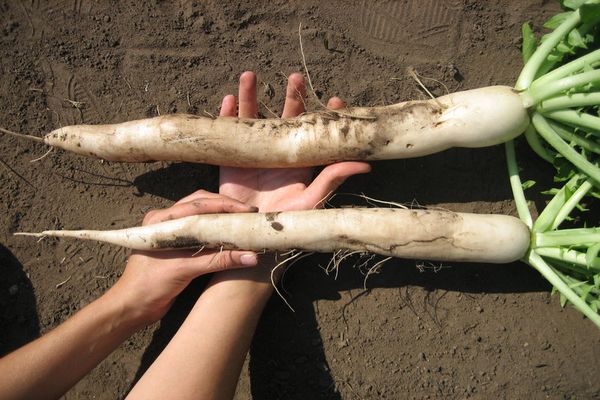
When the vegetable rises above the soil, they resort to hilling. You can replace such a laborious procedure by mulching the bed with compost or peat. Water the culture 2 times a week, with extreme heat and drought, humidification is carried out every other day.
Organics with a lot of nitrogen are not suitable for feeding Minovashi, since the growth of tops is enhanced. It is better to buy a comprehensive fertilizer in the form of Biohumus, Clean slate, Agricola. Top dressing is combined with watering.
Advantages and disadvantages
In ancient times, the Japanese appreciated the taste and unique properties of daikon. Not a single family can do without this product; root crops are used in many cuisines of other countries, in folk recipes for the treatment of diseases.
The Minovashi variety is not afraid of the heat, but it suffers from a drop in temperature, has many advantages, including:
- delicate taste of pulp;
- lack of bitterness;
- high productivity.
They eat not only root crops, but also young tops and leaves. One vegetable weighs up to 1.5 kg, and more than 10 kilograms are harvested from a square meter. Minovashi are planted by digging up potatoes, garlic, picking tomatoes or onions. The plant does not accumulate toxins, but has medicinal properties. Root crops have time to ripen even when sown in the second half of summer.

A significant disadvantage of the variety is that with a long daylight hours, the yield decreases sharply, since arrows are formed, due to which the development of root crops stops.
Minovashi reacts negatively to low air temperatures.
Pests and diseases
Compliance with the rules of agricultural technology, disinfection of seeds before planting, and removal of weeds helps to prevent the appearance of many problems in plants. Minovashi sometimes suffers:
- from felt disease;
- from the black leg;
- mucous bacteriosis;
- mosaics.
Root vegetables are crushed, stiff and bitter when the plant is infected with Keel's disease fungi. To eliminate it, planriz or Binoram biological products are used. To combat the black leg, Minovashi is watered with Fitosporin.

When slugs appear on the bed, they dig a groove into which wood ash is poured. When a culture is damaged by a mosaic, the soil is watered with a solution of potassium permanganate, the diseased plants are destroyed. Marigolds can be sown around the Minovashi planting; many insects cannot stand the scent of these flowers.
To cope with vascular bacteriosis, wet rot, plants are treated with fungicides Mikosan, Climate, Phytocide. Great harm to root crops is caused by the larvae of the beetle, the wireworm of the scoop. The preparations Calypso, Actellik, Prestige, Masterpiece help to get rid of insects.
Harvesting and storage
To use the Minovashi daikon in salads or side dishes, root vegetables are dug out 2 months after the sprouts emerge. A ripe vegetable lies until spring without losing its taste and useful properties. In order not to damage it, getting it out of the ground, the soil is watered. It is unlikely that it will be possible to pull out a root crop without a shovel.
Before laying Minovashi in a basement or cellar, where the temperature should not be higher than 4 degrees Celsius, the tops are cut, dried and put into boxes, sprinkled with river sand. Frozen vegetables, root vegetables with damaged skin will not be stored. Salads with dill and mayonnaise are prepared from them, Minovashi is stewed with squid, cut into rings, pickled and salted. In Japan, sushi is served with a daikon side dish.
Low-calorie roots are recommended for people who dream of losing weight. The healthy and tasty vegetable Minovashi is used for cooking in many countries, in addition to medications, it is used to treat colds, absorb edema, remove toxins and radiation from the body.
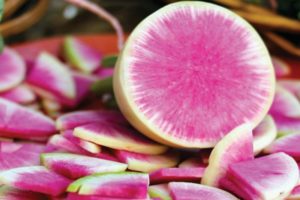
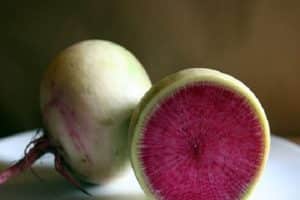
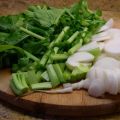
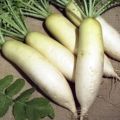
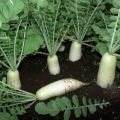
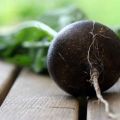
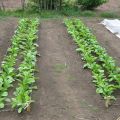
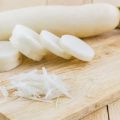
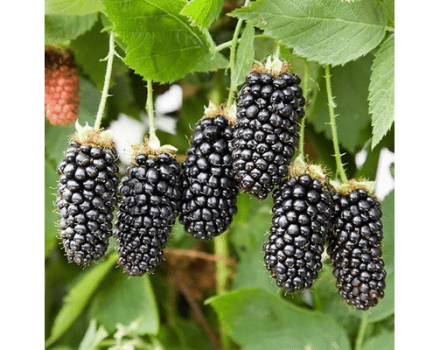
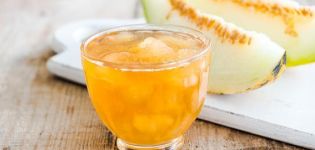
I really like this variety - the only one that I can safely eat just like that, without salt or vegetable oil. Sweetish, juicy. Last year I tried to use it when growing it BioGrow - so the fruits of the radish grew larger, while, despite my fears, they became tough, but remained as juicy.